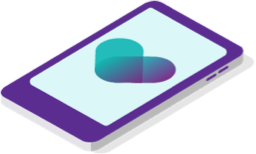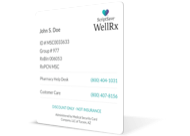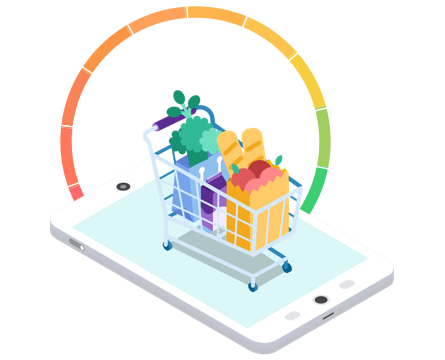Copyright 2024
Medical Security Card Company, LLC
All Rights Reserved
WellRx will never sell your personal information. Period. By signing up I agree to WellRx's terms of use and privacy policy.
By Teresa Otto, M.D.
December 19, 2022
The old terms — juvenile diabetes and adult-onset diabetes — just don’t work anymore. Neither do insulin-dependent and non-insulin-dependent diabetes. Now we call them Type 1 diabetes and type 2 diabetes, respectively.
Being young or using insulin doesn’t automatically mean you have type 1 diabetes. Being older doesn’t automatically mean you have type 2 diabetes. So, how do know the difference between these two diseases that together affect 37 million Americans?
We’ll compare both types, including the risk factors, symptoms, and treatment. You’ll also discover how to find the lowest price on diabetes medications at a pharmacy near you.
Both type I and type II diabetes cause you to have abnormal blood sugar (aka blood glucose), but the two are separate diseases. Even though elevated blood sugar occurs with both types of diabetes, the ways each disease causes this to happen are different.
To see how type 1 and type 2 diabetes differ, you need to know how the carbohydrates you eat become fuel for your cells. Here’s how the process normally works:
The glucose you don’t immediately need gets stored in your liver and muscles as a sugar conglomerate called glycogen. Glycogen gets taken out of storage and broken down to glucose when you need energy between meals, when sleeping or while exercising.
With type 1 diabetes, your pancreas produces little to no insulin. Your blood sugar levels are high, but the amount of glucose going into your cells for fuel is low. You need to take insulin to survive.
Type 1 diabetes often begins in children and teens, hence the old name — juvenile diabetes. But adults may also develop type 1 diabetes.
Type 2 diabetes leads to elevated blood sugar, just like type 1 diabetes, but the mechanism behind the disease is different.
In type 2 diabetes, your pancreas makes insulin, but your body doesn’t respond to the insulin normally. Your body becomes resistant to insulin’s action. Insulin’s signal for glucose to enter your cells and provide energy is ignored, and the glucose remains in your bloodstream.
If your type 2 diabetes is left untreated, your body eventually slows its insulin production.
Type 2 diabetes was once a disease of middle-aged and older adults and was called adult-onset diabetes. Now growing numbers of children and teens are being diagnosed with type 2 diabetes.
Both type 1 and type 2 diabetes may run in families through genes you inherit. But that’s not the entire story. For the disease to develop, researchers believe you also need environmental triggers to switch on the particular gene. The genes, risk factors, and environmental triggers vary between type 1 and type 2 diabetes.
Caucasians are more likely to carry genes for type 1 diabetes. Most people who carry the gene for type 1 diabetes don’t get the disease, however, because the gene isn’t activated. Researchers continue to look for environmental triggers. Here are several known and likely triggers:
Type 2 diabetes also runs in families and has a genetic component. The most common risk factor or trigger for type 2 diabetes is obesity. This and other modifiable risk factors include:
Unfortunately, some risk factors can’t be changed. They include:
Since high blood sugar causes the symptoms of diabetes, symptoms for both type 1 and type 2 diabetes are similar:
Type I diabetes symptoms may appear suddenly and be very pronounced. Infants and children may fail to thrive and gain weight. Or a child may come to the emergency room with abnormal breathing, fruity-smelling breath, and altered consciousness due to diabetic ketoacidosis — a life-threatening condition requiring immediate medical attention.
Type 2 diabetes, on the other hand, usually has a gradual onset of symptoms. Since symptoms may appear slowly, having complications from diabetes may be your first sign of the disease. Complications include:
Your healthcare provider will diagnose diabetes based on your symptoms and blood tests. Tests measure both blood sugar (glucose) and hemoglobin A1C.
A random, non-fasting blood sugar greater than 200 mg/dl (milligrams per deciliter) with symptoms of diabetes suggests you have either type 1 or type 2 diabetes.
A blood sugar drawn after you’ve been fasting for 8 or more hours is a more reliable test. If your result shows a blood sugar:
A hemoglobin A1C test shows how high your blood sugar has been for the last 60 to 90 days. A result of:
Type 1 diabetes has long been considered a disease that couldn’t be delayed once you had it. Scientists are finding it may be hidden for years before you develop symptoms, offering hope that it can be postponed or even prevented.
In November 2022, the Food and Drug Administration approved teplizumab (TZIELD), a drug that slows the onset of type 1 diabetes. The FDA approved teplizumab for adults and children over 8 years of age who make antibodies (proteins) that attack their insulin-producing cells.
Additional studies on delaying and preventing type 1 diabetes continue. If you have a family history of type 1 diabetes, you may be able to participate in one of these studies.
Type 2 diabetes can be delayed or prevented, especially if you adopt lifestyle changes in the prediabetic phase. During prediabetes, your blood sugars are mildly elevated but not high enough to be type 2 diabetes. One in three (96 million) Americans is prediabetic.
Unfortunately, 8 out of 10 people with prediabetes are asymptomatic and unaware of their elevated blood sugars. Learning you’re prediabetic through blood sugar testing and then making lifestyle changes may help prevent or delay the onset of type 2 diabetes. These changes include:
Both Medicare and the Centers for Disease Control and Prevention offer lifestyle change programs.
If you have type 1 diabetes, you will need insulin. You can inject insulin under your skin. It can be automatically injected, based on your blood sugar, by a small, computerized device called an insulin pump.
Over 20 types of insulin are available in the United States, including:
If you have type 2 diabetes and lifestyle changes don’t lower your blood sugar enough, your healthcare provider will recommend medication. Although everyone with type 1 diabetes needs insulin, most people with type 2 diabetes will manage with oral or injected medications other than insulin. There are dozens on the market, including:
We’ve come a long way concerning treating diabetes since insulin was discovered in 1921 and first used to treat diabetes in 1922. You and your healthcare provider now have multiple types of insulin, non-insulin, and disease-modifying medications to choose from. And you have your choice of pharmacies.
At ScriptSave WellRx, you can enter the name of any prescription or over-the-counter medications you take along with your zip code to instantly compare prescription prices in your neighborhood. WellRx also offers coupons for medications and free Rx savings cards.
To discover how prescription discount cards work, watch this 30-second video. Then sign up for your free prescription drug card at WellRx.
Teresa Otto, MD, is a freelance medical writer on a mission to inform readers about the positive impact of good nutrition and a healthy lifestyle. She is a retired anesthesiologist who practiced in Billings, Montana, for most of her career. She graduated from the University of Washington School of Medicine in Seattle and did her anesthesia residency and fellowship at New York University and Columbia-Presbyterian in New York.
Resources:

For your convenience, use the ScriptSave® WellRx mobile app. Now savings are well in hand, right at the pharmacy counter. Save on your family's prescription medicines.
Learn More
Your choice. Get a ScriptSave WellRx Savings Card. Or Download the free mobile app from the App Store or Google Play Store
Get A Card
ScriptSave WellRx Grocery Guidance leverages leading-edge nutritional data science to help you know which food products on your grocery store shelf are truly good for YOU.
Healthy Foods For YouTags:

November 07, 2024

October 23, 2024

May 07, 2024
You need to log into the site to use this feature
This feature requires registration. Sign up or log in to your free WellRx account to gain access to this and other tools to help make managing your medications and wellness easier.
Benefits Include:
 Store & manage your medication list
Store & manage your medication list
 Medication pricing updates
Medication pricing updates
 Medication information
Medication information
 Pill & refill reminders
Pill & refill reminders
 Medication journal & mood log
Medication journal & mood log
This feature requires registration. Sign up or log in to your free WellRx account to gain access to this and other tools to help make managing your medications and wellness easier.
Benefits Include:
 Store & manage your medication list
Store & manage your medication list
 Medication pricing updates
Medication pricing updates
 Medication information
Medication information
 Pill & refill reminders
Pill & refill reminders
 Medication journal & mood log
Medication journal & mood log
You will be redirected to your program in 5 seconds.
Our Terms and Conditions and Privacy Policy have recently been updated.
By declining you will be logged out of your account